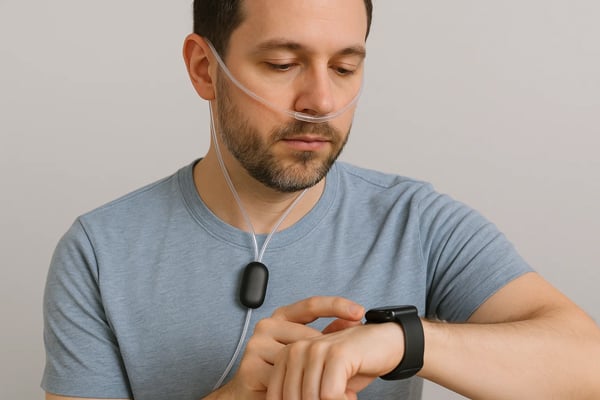
When you think of oxygen therapy, you might imagine a heavy tank, a nasal cannula, and a patient limited to home or hospital use. But respiratory care is evolving rapidly. By 2030, a combination of an aging population, rising cases of chronic respiratory disease, and technological advancements will reshape how supplemental oxygen is delivered, monitored, and managed. At LPT Medical, we are closely observing these trends and preparing for the next era of oxygen therapy. Here’s what patients, caregivers, and providers can expect in the years ahead.
Smarter, Connected Devices: The Rise of Therapy + Data
Today’s oxygen concentrators already offer lighter-weight, quieter motors and improved portability. By 2030, these devices will become smart, connected hubs that do more than deliver oxygen—they will actively provide real-time data and insights to improve therapy outcomes. Remote monitoring will allow providers or caregivers to track oxygen usage, device performance, and patient oxygen saturation from anywhere, enabling faster intervention when needed. Artificial intelligence will automatically optimize delivery, adjusting flow rates based on activity, breathing patterns, and health trends. Integration with wearable devices, such as smartwatches and health sensors, will enable continuous monitoring of heart rate, activity level, and respiratory patterns. Patients can expect less guesswork, fewer manual adjustments, and a smoother, more personalized therapy experience.
Enhanced Portability & Freedom of Movement
Mobility has always been a significant challenge for oxygen users. Heavy devices, short battery life, and cumbersome equipment have limited independence. By 2030, portable oxygen concentrators will be lighter, more compact, and capable of running an entire day on a single charge. This means users can confidently travel, attend social events, or spend time outdoors without constantly worrying about battery life or access to power. Travel-friendly designs with swappable batteries and FAA approval will make air and long-distance travel more feasible. Oxygen therapy will support active lifestyles, allowing patients to remain engaged in hobbies, travel, and social interactions without restriction.
Higher Flow, Smarter Delivery & Expanded Indications
Historically, oxygen therapy options have been limited by device size, power requirements, and usability. In the coming years, portable units will deliver higher oxygen flow rates while remaining compact and lightweight. Adaptive delivery systems will adjust oxygen output depending on activity, sleep, or rest, ensuring optimal therapy at all times. Oxygen therapy will expand to serve more patients, including those with milder conditions, those earlier in their illness, and even individuals using oxygen for preventive respiratory health. Patients will experience therapy that is more effective, flexible, and accessible, tailored to their lifestyle and medical needs.

Sustainability, Efficiency & Global Access
As oxygen devices evolve, sustainability will play an increasingly important role. Future units will be energy-efficient, use eco-friendly materials, and have longer lifespans with easier servicing. Improved durability and portability will expand access to oxygen therapy worldwide, including in regions with limited infrastructure. Predictive maintenance and connected monitoring will reduce downtime, lower operational costs, and support programs for device reuse, rental, or refurbishment. Patients and providers will benefit from devices that are more reliable, cost-effective, and environmentally responsible.
Changing Ecosystem: From Device to Platform
By 2030, oxygen therapy will be part of a broader healthcare ecosystem, integrating devices, data, and services to improve patient outcomes. Subscription and rental models will combine equipment with ongoing care, monitoring, and telehealth support. Connected devices will empower patients with insights into their therapy and enable clinicians to adjust treatment proactively. This holistic approach will enhance compliance, reduce hospitalizations, and improve quality of life. Regulatory and safety standards will evolve alongside technology, ensuring secure, reliable, and effective therapy for every user.
LPT Medical’s Vision for 2030
At LPT Medical, we aim to provide oxygen users with freedom, confidence, and mobility. Our focus is on curating next-generation devices with features such as adaptive oxygen delivery, intelligent connectivity, extended battery life, and travel-friendly designs. We are exploring models that integrate devices, data, and care plans into one seamless experience. By supporting global access, educating patients and caregivers, and promoting sustainable practices, we are preparing for a future where oxygen therapy empowers rather than restricts.
Key Considerations for Patients, Caregivers & Providers
As oxygen therapy evolves, it’s important to consider innovative features, battery life, portability, serviceability, total cost of ownership, sustainability, and clinical suitability. Choosing the correct device today can future-proof care and ensure ongoing independence, comfort, and safety. Patients should seek devices that adapt to changing health needs, integrate with telehealth systems, and enable a more active life.
Conclusion
The next decade in oxygen therapy promises a remarkable transformation. Devices will become intelligent, adaptive, and connected; portable units will be lighter, more efficient, and travel-ready; and care systems will integrate data, monitoring, and personalized therapy to optimize outcomes. For patients and providers, this is more than a technical advancement—it’s an opportunity for greater independence, improved results, and a higher quality of life. LPT Medical is committed to helping every user breathe easier, live better, and move more freely as we approach 2030. The future of oxygen therapy is bright, and the journey has already begun.
Questions? Call us at 800-946-1201


.png)



